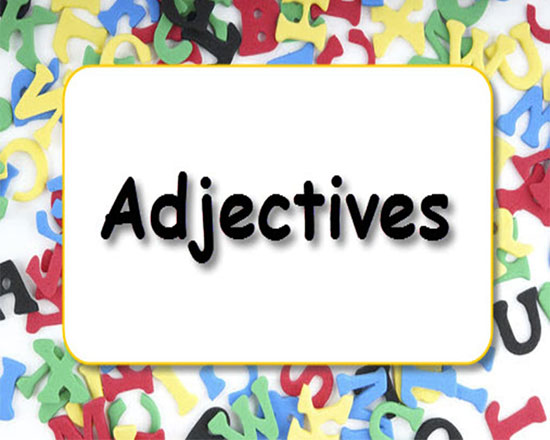صفت در زبان انگلیسی (Adjectives)

صفت در انگلیسی افراد، مکانها و اشیا را توصیف میکند. قصد داریم با آموزش زبان انگلیسی قوانین استفاده از صفتها در جملات، بتوانید انگلیسی خود را دقیقتر و بیشتر توصیف کنید. در ادامه به آموزش صفت در زبان انگلیسی (Adjectives) میپردازیم.
Functions of adjectives
Adjectives describe the aspects of nouns. When an adjective is describing a noun, we say it is “modifying” it. Adjectives can:
Describe feelings or qualities,
Examples
- He is a lonely man.
- They are honest.
Give nationality or origin,
Examples
- I heard a French song.
- This clock is German.
- Our house is Victorian.
Tell more about a thing’s characteristics,
Examples
- That is a flashy car.
- The knife is sharp.
Tell us about age,
Examples
- He’s a young man.
- My coat is old.
Tell us about size and measurement,
Examples
- John is a tall man.
- This film is long.
Tell us about colour,
Examples
- Paul wore a red shirt.
- The sunset was crimson.
Tell us what something is made of,
Examples
- The table is wooden.
- She wore a cotton dress.
Tell us about shape,
Examples
- I sat at a round table.
- The envelope is square.
Express a judgement or a value.
Examples
- That was a fantastic film.
- Grammar is complicated.
Using adjectives in English
Adjectives in English are invariable. They do not change their form depending on the gender or number of the noun.
Examples
- This is a hot
- Those are some hot
To emphasise or strengthen the meaning of an adjective, use the adverbs very or really in front of the adjective you want to strengthen.
Examples
- This is a very hotpotato
- Those are some really hot
Adjectives in English usually appear in front of the noun that they modify.
Examples
- The beautifulgirl ignored me.
- The fast redcar drove away.
Adjectives can also appear after being and sensing verbs like to be, to seem , to look & to taste.
Examples
- Italy is beautiful.
- I don’t think she seems niceat all.
- You look tired.
- This meat tastes funny.
Some exceptions
Adjectives appear after the noun in some fixed expressions.
Examples
- The Princess Royalis visiting Oxford today.
- The President electmade a speech last night.
- He received a court martialthe following week.
The adjectives involved, present & concerned can appear either before or after the noun that they modify, but with a different meaning depending on the placement.
Examples
| Adjective placed after the noun | Meaning | Adjective placed before the noun | Meaning |
| I want to see the people involved. | I want to see the people who have something to do with this matter. | It was an involved discussion. | The discussion was detailed & complex. |
| Here is a list of the people present at the meeting. | Here is a list of the people who were at the meeting. | The present situation is not sustainable. | The current situation is not sustainable. |
| I need to see the man concerned by this accusation. | I need to see the man who has been accused. | A concerned father came to see me today. | A worried father came to see me today. |
Ordering multiple adjectives
When a number of adjectives are used together, the order depends on the function of the adjective. The usual order is:
quantity, value/opinion, size, temperature, age, shape, colour, origin, material
| What the adjective expresses | Examples |
|---|---|
| Quantity | four, ten, a few, several |
| Value/opinion | delicious, charming, beautiful |
| Size | tall, tiny, huge |
| Temperature | hot, cold |
| Age | old, young, new, 14-year-old |
| Shape | square, round |
| Color | red, purple, green |
| Origin | Swedish, Victorian, Chinese |
| Material | glass, silver, wooden |
Examples
- They have a lovely old red post-box.
- The playroom has six small round plastic tables.
- I bought some charming Victorian silver ornaments at the flea market.
- She is selling her flashy 3-year-old Italian car.
- It was a beautiful cold day.
The comparative and the superlative
Comparative adjectives
Comparative adjectives are used to compare differences between the two objects they modify (larger, smaller, faster, higher). They are used in sentences where two nouns are compared, in this pattern:
Noun (subject) + verb + comparative adjective + than + noun (object).
The second item of comparison can be omitted if it is clear from the context (final example below).
Examples
- My house is larger than hers.
- This box is smaller than the one I lost.
- Your dog runs faster than Jim’s dog.
- The rock flew higher than the roof.
- Jim and Jack are both my friends, but I like Jack better. (“than Jim” is understood)
Superlative adjectives
Superlative adjectives are used to describe an object which is at the upper or lower limit of a quality (the tallest, the smallest, the fastest, the highest). They are used in sentences where a subject is compared to a group of objects.
Noun (subject) + verb + the + superlative adjective + noun (object).
The group that is being compared with can be omitted if it is clear from the context (final example below).
Examples
- My house is the largest one in our neighborhood.
- This is the smallest box I’ve ever seen.
- Your dog ran the fastest of any dog in the race.
- We all threw our rocks at the same time. My rock flew the highest. (“of all the rocks” is understood)
Forming regular comparatives and superlatives
Forming comparatives and superlatives is easy. The form depends on the number of syllables in the original adjective.
One syllable adjectives
Add -er for the comparative and -est for the superlative. If the adjective has a consonant + single vowel + consonant spelling, the final consonant must be doubled before adding the ending.
| Adjective | Comparative | Superlative |
|---|---|---|
| tall | taller | tallest |
| fat | fatter | fattest |
| big | bigger | biggest |
| sad | sadder | saddest |
Two syllables
Adjectives with two syllables can form the comparative either by adding -er or by preceeding the adjective with more. These adjectives form the superlative either by adding -est or by preceeding the adjective with most. In many cases, both forms are used, although one usage will be more common than the other. If you are not sure whether a two-syllable adjective can take a comparative or superlative ending, play it safe and use more and most instead. For adjectives ending in y, change the y to an i before adding the ending.
| Adjective | Comparative | Superlative |
|---|---|---|
| happy | happier | happiest |
| simple | simpler | simplest |
| busy | busier | busiest |
| tilted | more tilted | most tilted |
| tangled | more tangled | most tangled |
Three or more syllables
Adjectives with three or more syllables form the comparative by putting more in front of the adjective, and the superlative by putting most in front.
| Adjective | Comparative | Superlative |
|---|---|---|
| important | more important | most important |
| expensive | more expensive | most expensive |
Irregular comparatives and superlatives
These very common adjectives have completely irregular comparative and superlative forms.
| Adjective | Comparative | Superlative |
|---|---|---|
| good | better | best |
| bad | worse | worst |
| little | less | least |
| much | more | most |
| far | further / farther | furthest / farthest |
Examples
- Today is the worst day I’ve had in a long time.
- You play tennis better than I do.
- This is the least expensive sweater in the store.
- This sweater is less expensive than that one.
- I ran pretty far yesterday, but I ran even farther today.
Adjectives comparing equal quantities
To compare two things that are equal, we use the pattern:
as + adjective indicating quantity + (noun) + as
The quantity adjective you use depends if the noun in the comparison is countable or uncountable.
Countable nouns
Use as many and as few with countable nouns. Note that the noun may be ommitted when it is understood from the context, as in the last example below.
Examples
- They have as many children as we do.
- We have as many customers as they do.
- Tom has as few books as Jane.
- There are as few houses in his village as in mine.
- You know as many people as I do.
- I have visited the States as many times as he has.
- I have three brothers. That’s as many as you have. (“brothers” is understood)
Uncountable nouns
Use as much or as little with uncountable nouns. Note that the noun may be ommitted when it is understood from the context, as in the last example below.
Examples
- John eats as much food as Peter.
- Jim has as little patience as Sam.
- You’ve heard as much news as I have.
- He’s had as much success as his brother has.
- They’ve got as little water as we have.
- I’m not hungry. I’ve had as much as I want. (“food” is understood)
Adjectives comparing unequal quantities
To compare two things that are unequal, we use the pattern:
adjective indicating quantity + (noun) + than
The quantity adjective you use depends if the noun in the comparison is countable or uncountable.
Countable nouns
Use more and fewer with countable nouns. Note that the noun may be ommitted when it is understood from the context, as in the last example below.
Examples
- They have more children than we do.
- We have more customers than they do.
- Tom has fewer books than Jane.
- There are fewer houses in his village than in mine.
- You know more people than I do.
- I have visited the States more times than he has.
- I have three brothers. That’s more than you have. (“brothers” is understood)
Uncountable nouns
Use more or less with uncountable nouns. Note that the noun may be omitted when it is understood from the context, as in the last example below.
Examples
- John eats more food than Peter.
- Jim has less patience than Sam.
- You’ve heard more news than I have.
- He’s had more success than his brother has.
- They’ve got less water than we have.
- I’m not hungry at all. I’ve had more than I want. (“food” is understood)







دیدگاهتان را بنویسید